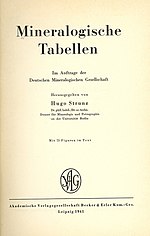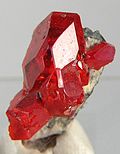overview of the classification of non-silicate minerals and includes mostly International Mineralogical Association (IMA) recognized minerals and its groupings...
104 KB (8,558 words) - 16:56, 20 December 2021
Silicate minerals are rock-forming minerals made up of silicate groups. They are the largest and most important class of minerals and make up approximately...
20 KB (1,897 words) - 18:21, 16 July 2024
overview of the classification of minerals (silicates) and includes mostly International Mineralogical Association (IMA) recognized minerals and its groupings...
50 KB (4,887 words) - 15:54, 4 April 2024
broad classes: Classification of non-silicate minerals Classification of silicate minerals Classification of organic minerals List of minerals Media related...
607 bytes (108 words) - 10:45, 12 January 2023
fallback Classification of non-silicate minerals – List of IMA recognized minerals and groupings Classification of silicate minerals – List of IMA recognized...
43 KB (2,846 words) - 19:16, 19 December 2024
unclassified silicates Subclass: germanates Classification of non-silicate minerals Classification of silicate minerals Hey's Mineral Index Timeline of the discovery...
8 KB (625 words) - 15:13, 9 December 2024
the classification temperature.[citation needed] There are several types of high-temperature mineral wool made from different types of minerals. The...
21 KB (2,656 words) - 22:11, 6 July 2024
Calcium silicate can refer to several silicates of calcium including: 2CaO·SiO2, larnite (Ca2SiO4) 3CaO·SiO2, alite or (Ca3SiO5) 3CaO·2SiO2, (Ca3Si2O7)...
16 KB (1,394 words) - 12:01, 31 July 2024
Minerals are classified by key chemical constituents; the two dominant systems are the Dana classification and the Strunz classification. Silicate minerals...
111 KB (13,154 words) - 06:02, 25 December 2024
Classification of non-silicate minerals Classification of silicate minerals http://www.minerals.net/mineral/sort-met.hod/group/sulfgrp.htm Minerals.net...
14 KB (1,533 words) - 10:36, 2 December 2024
Talc (redirect from Magnesium Silicate)
Talc, or talcum, is a clay mineral composed of hydrated magnesium silicate, with the chemical formula Mg3Si4O10(OH)2. Talc in powdered form, often combined...
38 KB (4,191 words) - 12:23, 2 January 2025
diagram of carbon Biotite series (micas) Earth sciences portal Classification of minerals - Non silicates Classification of minerals - Silicates Geology...
46 KB (4,998 words) - 22:27, 27 November 2024
Minerals are minerals which contain a borate anion group. The borate (BO3) units may be polymerised similar to the SiO4 unit of the silicate mineral class...
10 KB (947 words) - 21:18, 26 July 2023
Dana's classification is a mineral classification developed by James Dwight Dana. It is based on the chemical composition and structure of minerals. It is...
9 KB (492 words) - 14:24, 26 April 2024
Mineral hydration is also a process in the regolith that results in conversion of silicate minerals into clay minerals.[citation needed] Some mineral...
6 KB (611 words) - 11:08, 4 January 2025
the silicate minerals formed by lithophile elements, chalcophile elements separated below the lithophiles at the time of the first crystallization of the...
21 KB (2,551 words) - 02:51, 25 November 2024
Carbonate minerals are those minerals containing the carbonate ion, CO2− 3. Calcite group: trigonal Calcite CaCO3 Gaspéite (Ni,Mg,Fe2+)CO3 Magnesite MgCO3...
12 KB (1,159 words) - 00:09, 10 February 2024
Biomineralization (redirect from Biogenic minerals)
members that are able to form minerals, and over 60 different minerals have been identified in organisms. Examples include silicates in algae and diatoms, carbonates...
100 KB (10,410 words) - 02:37, 4 December 2024
sheet silicate (phyllosilicate) minerals, now grouped together as clay minerals. Their structure is based on flat hexagonal sheets similar to those of the...
26 KB (2,840 words) - 14:16, 31 July 2024
Shattuckite (category Silicate mineral stubs)
Shattuckite is a copper silicate hydroxide mineral with formula Cu5(SiO3)4(OH)2. It crystallizes in the orthorhombic – dipyramidal crystal system and usually...
4 KB (273 words) - 15:08, 17 December 2024
Sandstone (category Industrial minerals)
of the sandstone. These cementing materials may be either silicate minerals or non-silicate minerals, such as calcite. Silica cement can consist of either...
35 KB (3,934 words) - 16:43, 23 December 2024
Native element minerals are those elements that occur in nature in uncombined form with a distinct mineral structure. The elemental class includes metals...
8 KB (739 words) - 11:47, 15 August 2024
oxide mineral class includes those minerals in which the oxide anion (O2−) is bonded to one or more metal alloys. The hydroxide-bearing minerals are typically...
18 KB (1,957 words) - 06:51, 23 October 2024
Zeolite (category Industrial minerals)
permanently trapped. Equally important are the mineral properties of zeolites. Their alumino-silicate construction is extremely durable and resistant...
53 KB (5,846 words) - 20:24, 6 January 2025
Diamond inclusions (section Mineral inclusions)
discovery of the natural form of minerals which have previously been only synthesized in the laboratory. For instance, the natural calcium silicate perovskite...
23 KB (2,184 words) - 07:56, 15 April 2024
Phosphate minerals are minerals that contain the tetrahedrally coordinated phosphate (PO3−4) anion, sometimes with arsenate (AsO3−4) and vanadate (VO3−4)...
20 KB (2,249 words) - 12:00, 15 December 2024
Glances (category Classification of minerals)
2009. — 556 p. — ISBN 978-5-288-04863-0 Lustre (mineralogy) Sulfide mineral Selenide minerals Telluride mineral Classification of non-silicate minerals...
15 KB (1,820 words) - 03:05, 21 October 2024
Clastic rock (section Classification)
millimeters. However, the term can also be used to refer to a family of sheet silicate minerals. Silt refers to particles that have a diameter between .062 and...
21 KB (2,642 words) - 04:07, 17 February 2024
Lipscombite (category Manganese(II) minerals)
because crystal-forming conditions of pressure and temperature are brief. In the Classification of non-silicate minerals lipscombite is in the lipscombite...
5 KB (347 words) - 15:47, 13 December 2024
Halide minerals are those minerals with a dominant halide anion (F−, Cl−, Br− and I−). Complex halide minerals may also have polyatomic anions. Examples...
12 KB (1,271 words) - 18:28, 29 October 2023






















